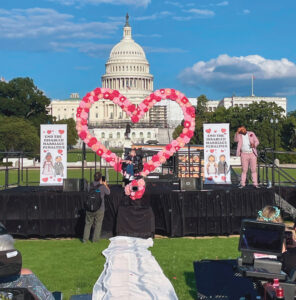
Disability Benefits and the Marriage Penalty
By Barbara and Jim Twardowski, RN | Monday, February 12, 2024
5 Second Summary
For people with disabilities, getting married may mean losing vital benefits. Couples and disability advocates are working to change the rules.
After dating for six years, Gabriella Garbero’s boyfriend, Juan Johnson, popped the question on New Year’s Eve in 2021. She enthusiastically accepted his proposal.

Gabriella Garbero and Juan Johnson haven’t set a wedding date.
Three years later, the couple still has not tied the knot. Gabriella, an attorney and disability advocate, has spinal muscular atrophy (SMA) and relies on aides and nurses to provide care in her home. Gabriella’s and Juan’s combined income and assets exceed Medicaid’s allowable limits. If they were to marry, Gabriella would lose the Medicaid benefits that help keep her alive. She estimates her in-home care would cost between $100,000 to $200,000 per year if she were paying for these services herself.
Gabriella’s Medicaid eligibility is tied to qualifying for Supplemental Security Income (SSI). This needs-based government program provides a modest monthly income to people with disabilities. For 2024, the maximum monthly payment is $943 for an individual.
SSI also stipulates that a recipient’s countable assets (a bank account, financial investments, or property) must not exceed $2,000. For a married couple, SSI counts their combined income and assets regardless of the disability status of the spouse. They may not exceed a total of $3,000.
Forced to choose between having the daily care Gabriella needs or getting married, the couple has postponed their wedding indefinitely.
“We might be engaged for 10 or 20 years and never get married, although I hope not. I hope something changes before then,” Gabriella says.
Marriage inequality
Culturally, Americans have seen inequalities in marriage rights before. We have seen the laws change to allow interracial marriages and, more recently, same-sex marriages.
Marriage equality for the disability community is somewhat different. While disabled people are not prohibited from marrying, the rules to qualify for government benefits penalize those who do marry.
More than 7.6 million Americans who receive SSI benefits are impacted by rules regarding marital status.
Even couples that are not legally married risk facing penalties. If the Social Security Administration, which administers SSI, determines that two people are presenting themselves as married to the community, their SSI benefits are calculated as though they are a legally married couple. Something as simple as how you introduce your significant other can have devastating consequences.
The high cost of marriage

Ashleigh and James Ocasio knew getting married would affect their disability benefits.
Before Ashleigh and James Ocasio married, they spent a long time discussing the potential ramifications of their union.
Ashleigh has limb-girdle muscular dystrophy (LGMD). “I need help with everything: getting dressed, doing my hair, brushing my teeth, toileting, and showering. Sometimes, even assistance with eating,” Ashleigh says. Her home healthcare services provided by four professional caregivers cost more than $1,000 per week. Medicaid and her state’s waiver program pay for this, as well as additional medical expenses.
To keep Ashleigh’s benefits, the couple needed to earn less. James took a lower-paying job and became Ashleigh’s primary caregiver. Due to a shortage of home health workers in their area, Ashleigh now has only one outside caregiver.
“Except for one person who comes in once a week to help, the caregiving is all down to my husband now,” Ashleigh says. This situation takes a toll on their marriage. “Sometimes it’s hard to separate caregiving from the romantic spousal relationship. So, we’ve had to work through that. We go to therapy to help us with managing that relationship, and we’re only a year in.”
To marry or not?
The rules surrounding eligibility for Medicaid, SSI, and other benefit programs are complex.
Medicaid is a joint federal-state program, and the eligibility and benefits vary from one state to another. Some states use the same eligibility rules and application process for SSI and Medicaid, while other states have different eligibility rules and/or require a separate application for Medicaid. To learn about the rules in your state, contact your state Medicaid agency.
SSI eligibility, payments, and asset limits are determined at the federal level by the Social Security Administration. Currently, when two people who rely on SSI get married, their monthly income benefit is reduced by 25%. An individual receives $943 each month, but two people receiving SSI who are married do not receive double that, which would be $1,886. Instead, their monthly benefit is $1,415. That’s almost $500 per month less.
In addition, the allowable assets threshold is $2,000 for an individual on SSI and $3,000 for a married couple, even if only one member of the couple qualifies for SSI. This is yet another 25% reduction.
Ashleigh and James, who is deaf, both receive SSI and Medicaid benefits. Since getting married in 2022, they have been living paycheck to paycheck on a tight budget. They do not have a retirement fund or a savings account for emergency expenses.
In her work as a Family and Clinical Support Specialist for MDA, Ashleigh frequently talks to clients who had no idea that getting married would alter their benefits until after they did so. She also talks to people who are contemplating never getting married or divorcing because they need their benefits.
“I don’t regret getting married, especially because of where I live,” says Ashleigh. Iowa, her home state, recognizes common-law marriage. “It didn’t matter if we got legally married or just continued dating while living together because either way, it was going to count against us. At least I get to have the semblance of a normal marriage.”
Marriage equality movement

Ayesha Lewis is an attorney with the Disability Rights Education and Defense Fund.
Many people with disabilities, including those with neuromuscular diseases, rely on SSI, and in most cases, they are eligible for Medicaid. The marriage penalties baked into Medicaid and SSI benefits have a profound effect on the disability community, according to Ayesha Lewis, an attorney with the Disability Rights Education and Defense Fund — and it’s not just economic.
“These barriers to marriage are patronizing,” Ayesha says. “They treat people as if they’re not able to live the kind of full lives that we know people with disabilities are capable of and live every day. I’ve spoken to a lot of folks across the country, and they see this as an affront to their dignity, humanity, and equality.”
Fortunately, lawmakers are beginning to see that point of view. In 2023, Senators Bill Cassidy (R-LA) and Sherrod Brown (D-OH) introduced the SSI Savings Penalty Elimination Act, bipartisan legislation that changes the existing SSI asset limits. If passed, this bill would increase asset limits to $10,000 for individuals and $20,000 for couples, with adjustments for inflation each year. (Learn more about MDA’s work on SSI benefits.)
Awareness of the marriage equality issue continues to grow. In September 2023, numerous media outlets covered a mass commitment ceremony held on the National Mall in Washington, DC, where couples with disabilities recited non-legally binding vows under banners declaring, “End the disabled marriage penalties.” Many attendees said they would get married if SSI’s policies changed.
“The engagement around this issue is heartwarming,” Ayesha says. “We value equality. We value love. We want people to be able to live the lives they want regardless of their disability status.”
Barbara Twardowski has Charcot-Marie-Tooth disease (CMT) and uses a power wheelchair. Jim, her husband, is a registered nurse. The couple lives in Louisiana and writes about accessible travel, health, and lifestyle.
An Issue of Economic Independence

A commitment ceremony protesting marriage penalties was held in Washington, DC, in 2023.
The Supplemental Security Income (SSI) program was established 50 years ago, and the asset limits haven’t been updated since the 1980s. This doesn’t just create barriers to marriage for people with disabilities — it also affects their ability to work, get promoted, and save for the future.
The SSI Penalty Elimination Act, introduced in the US Senate in 2023, would go a long way toward providing economic independence for the disability community.
You can help by contacting your Congress members and telling them how the SSI Penalty Elimination Act would impact you or your loved ones. To act now, fill out MDA’s easy-to-use online form.
Next Steps and Useful Resources
- Listen to a Quest Podcast conversation with couples about the joys and challenges of marriage with a disability.
- Join MDA’s Grassroots Advocacy Network to add your voice to any of MDA’s initiatives that promote access to care, champion disability rights, and accelerate drug development.
- Stay up-to-date on Quest content! Subscribe to Quest Magazine and Newsletter.
Disclaimer: No content on this site should ever be used as a substitute for direct medical advice from your doctor or other qualified clinician.




